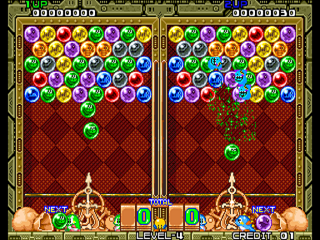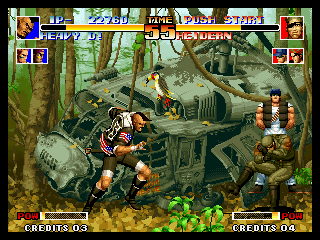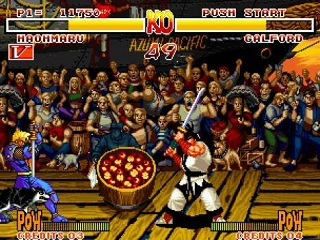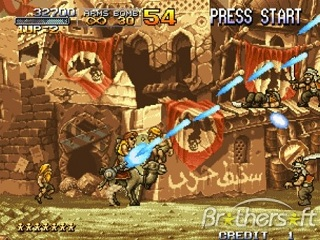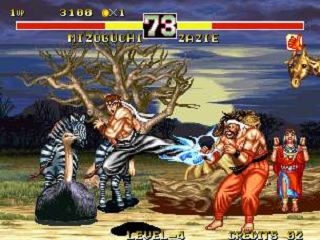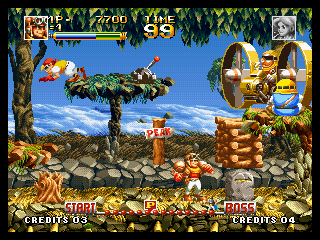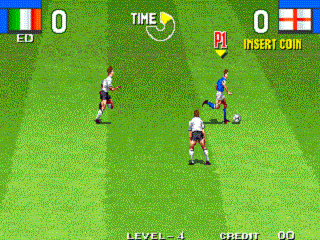Neo Geo AES
I have always been a big fan of arcade systems of many kinds. In order to supplement my puny ZX Spectrum clone, I visited local arcades and spent a pile of money on systems such as CPS-1, Taito, Atari, Playchoice-10, Data East. This was back in the early 90s. They all had good games, including the legendary Knights of the Round, which holds a special place in my heart. One day a friend told me of a new arcade that he had tried out, which was in downtown Bucharest, quite a ways from the familiar arcades that I knew so well. I believe it was around 1994 when I discovered Neo Geo games. For some reason, this arcade had significantly more Neo Geo games than any other. I'm probably forgetting some, but I remember Top Hunter, Agressors of Dark Combat, Karnov's Revenge, Samurai Shodown, Samurai Shodown 2, King of Fighters '94, Windjammers, Savage Reign were all there. A nearby arcade later brought in Double Dragon, King of Fighters 95, 96, 97, 98, and 99.
From a technical perspective, Neo Geo was superior to other arcade systems of its time. Backgrounds were more vibrant, with more action and motion due to faster processors. Animations were significantly smoother due to large amounts of memory. Sound effects and music were amazing - so amazing that it was the first system to be able to properly play voice. I still consider the parry sound in Samurai shodown to be the best parry sound in any fighting game yet. In my opinion, Neo Geo was the peak of 2D arcade gaming. Everything that came after was just not as impressive.
A significant portion of the home console games were arcade ports. People would see and play arcade games and would be very willing to pay in order to be able to play them at home. The downside was that home consoles were much weaker technically than arcade systems. This caused the ports to suffer from lower quality graphics, sound, and sometimes even controls. In the more extreme cases, the port played nothing like the arcade original; it was a totally different experience.
Along came the ambitious console named Neo Geo AES (Advanced Entertainment System). It was a bold experiment by SNK (Shin Nihon Kikaku), the creators of the Neo Geo. The prime design directive was that the AES must be able to play the arcade games from the Neo Geo arcade system (called MVS). AES was released in 1990 and its cartridges used the exact same ROM chips as the arcade cartridges. It was the first console to deliver true arcade quality at home.
Technically, the Neo Geo AES crushed its contemporaneous rivals, Super Nintendo Entertainment System, Sega Genesis (Megadrive in Europe) and the Turbografx-16 (PC-Engine). Basically, it lined its competitors up, dropped their pants and spanked them in front of everyone.
Here is a summarized chart comparing the AES to the others:
Its price crushed its buyers; it retailed for $649.99 with one game. Compare this to $199 for the SNES, $190 for the Sega Genesis, and $200 for Turbografx-16. To make things worse, AES cartridges retailed for $200 and up. In today's money, the AES console would cost just over $1,000, and games would cost at least $320 each. Not bad, eh?
From a technical perspective, Neo Geo was superior to other arcade systems of its time. Backgrounds were more vibrant, with more action and motion due to faster processors. Animations were significantly smoother due to large amounts of memory. Sound effects and music were amazing - so amazing that it was the first system to be able to properly play voice. I still consider the parry sound in Samurai shodown to be the best parry sound in any fighting game yet. In my opinion, Neo Geo was the peak of 2D arcade gaming. Everything that came after was just not as impressive.
A significant portion of the home console games were arcade ports. People would see and play arcade games and would be very willing to pay in order to be able to play them at home. The downside was that home consoles were much weaker technically than arcade systems. This caused the ports to suffer from lower quality graphics, sound, and sometimes even controls. In the more extreme cases, the port played nothing like the arcade original; it was a totally different experience.
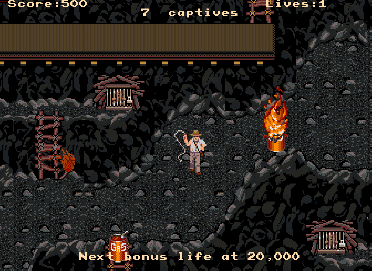
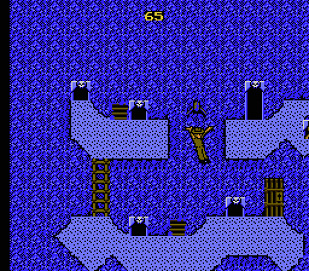
Indiana Jones and the Temple of Doom - Arcade original (left) vs. NES port (right)
Along came the ambitious console named Neo Geo AES (Advanced Entertainment System). It was a bold experiment by SNK (Shin Nihon Kikaku), the creators of the Neo Geo. The prime design directive was that the AES must be able to play the arcade games from the Neo Geo arcade system (called MVS). AES was released in 1990 and its cartridges used the exact same ROM chips as the arcade cartridges. It was the first console to deliver true arcade quality at home.
Technically, the Neo Geo AES crushed its contemporaneous rivals, Super Nintendo Entertainment System, Sega Genesis (Megadrive in Europe) and the Turbografx-16 (PC-Engine). Basically, it lined its competitors up, dropped their pants and spanked them in front of everyone.
Here is a summarized chart comparing the AES to the others:
| AES | SNES | Turbografx-16 | Sega Genesis | |
| On-screen colours | 4,096 | 256 | 482 | 64 |
| On-screen sprites | 384 | 128 | 64 | 80 |
| Sound channels | 15 | 8 | 6 | 6 |
Its price crushed its buyers; it retailed for $649.99 with one game. Compare this to $199 for the SNES, $190 for the Sega Genesis, and $200 for Turbografx-16. To make things worse, AES cartridges retailed for $200 and up. In today's money, the AES console would cost just over $1,000, and games would cost at least $320 each. Not bad, eh?

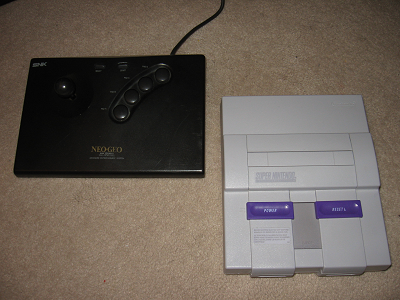
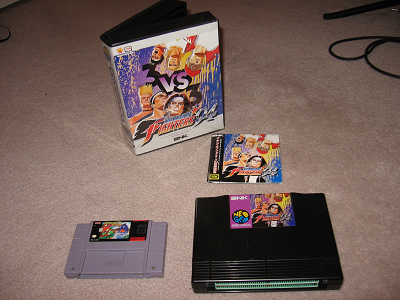 I have held off purchasing a Neo Geo AES for several years. The temptation was too great, however, and I gave in. When I showed the system to my brother, his reaction was amusing: "What the hell .. everything about this system is big." This is true; I've included several photos of the console, a game, and the controller. For size comparison, the photos show a SNES console and game. The AES console itself is larger than an XBOX (though not as thick).
I have held off purchasing a Neo Geo AES for several years. The temptation was too great, however, and I gave in. When I showed the system to my brother, his reaction was amusing: "What the hell .. everything about this system is big." This is true; I've included several photos of the console, a game, and the controller. For size comparison, the photos show a SNES console and game. The AES console itself is larger than an XBOX (though not as thick).
AES controllers feature the same layout as their arcade counterparts - a stick and four buttons labelled A, B, C, and D, positioned in a circular arc. Cartridges are almost as large as a SNES, and they have two edge connectors. The cartridges are my favourite. When you first pick up a boxed game, you realize that it weighs about a pound. I guess they truly are jam-packed with chips. One nice feature of most AES games is that the "meg count", that is, how many megabits the game data uses is written on the box. SNES cartridges go up to 48 megabits (the largest SNES game). While I do not know what the AES maximum is, I know that there are games over 700 megabits. The older AES game boxes feature hand-drawn pictures, as can be seen in the third photo, on the King of Fighters '94 box. They also seem to have a specific smell. I can't tell if it's the solder inside the cartridge, or the plastic of the game box, but I can definitely claim that I can recognize AES cartridges by their smell. The manuals are not too thick, and also feature hand-drawn graphics, sometimes even little comic strip panels. The fact that my AES game manuals are all in Japanese only adds to the charm. The only things I can read are words like "Super" or "Mega", and of course, the arrows indicating how to pull off special moves. The library of games is of decent size, at around 150 games. A vast majority of them are fighting games. Many of them feature combatants from different geographical locations, such as the World Heroes series, which features stereotypical fighters from all over the world, including Rasputin, a Hulk Hogan clone, Captain Kidd, etc. Yes, they are cheesy, but also great! The most recognizable games (surprisingly not fighters) are probably Bust-a-Move (also known as Puzzle Bobble) and Metal Slug. Bust-a-Move is the wonderfully addictive coloured-bubbles puzzle featuring the adorable dinosaurs Bub and Bob. Metal Slug games are known to push the rendering capabilities of the system to the limit with an insane number of on-screen sprites, detailed animations, and sometimes heavy lag. Today, the Neo Geo scene is vibrant with collectors. The console, games, and even accessories have all maintained their value. As of 2010, the console still goes for about $300. Games start at around $30 for the more common (and mostly older) ones, climbing up to $2,000 for the rare ones. They usually come in two versions, Japanese and English. The English versions tend to be significantly more expensive, possibly because of lower production amounts. Popular series increase in price chronologically. For example, King of Fighters '94 (J), the first of its series can be obtained for about $40. King of Fighters 2002 (J), the last of its series goes for $140 or more. The two rarest Neo Geo games are Kizuna Encounter (Eng), and Ultimate 11 (Eng). Both have been known to sell on online auction sites sometimes in excess of $10,000. Neo Geo online communities can be described as elitist. Topics such as conversion of MVS (significantly cheaper) to AES, MVS arcade cabinets, etc. are popular on forums such as neo-geo.com, and very often result in drama. It is customary for some forums users to include as their forum signature the serial number(s) of the pieces of hardware they own. While this can be seen as boasting, it can be forgiven, as it stems from an intense passion for the system. The serial of my AES is 135756. |
|
Below are some screenshots of representative Neo Geo games.
|
